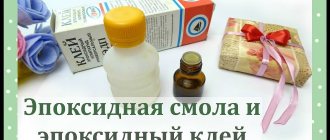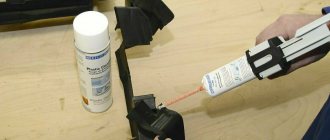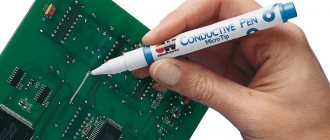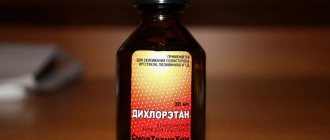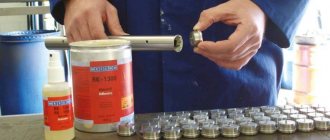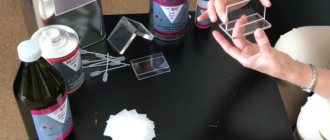Description and characteristics of epoxy glue
This product is widely used for household and industrial purposes, and is a popular synthetic substance included in tile mixtures, putty and primers. The adhesive is a combination of epoxy resin, polymers and solvent, the percentage of which is established by the technical nomenclature.
Thanks to its unique polymer composition, the product is used to bond different dense surfaces. You can use epoxy glue for metal, rubber, wood, concrete, leather, plastic.
The adhesive composition is sold ready-made or requires preparation: it can be liquid or thick (clay-like). Liquid is available in tubes, and plasticine is presented in bars of different sizes.
The technical characteristics of the glue are as follows:
- strength 100-400 kgf per 1 m2;
- polymerization time – 2 min – 3 h;
- operating temperature -20...+120°C (sometimes up to 270°C), best performance indicators - from +10°C to +25°C;
- hazard class – 3 (low hazard), but may cause skin allergies;
- average density per 1 m3 – 1.37 t;
- the shade can be transparent, white, gray, pink, silver, brown;
- average consumption 1 m2 – 1.1 kg;
- environmentally friendly, not recommended for gluing dishes (considered toxic).
Characteristics and instructions for use Source kraskaguru.ru
- sales form, available in tubes of 45-70 ml, syringes of 6-25 ml, packaging construction buckets, bottles, containers of 140, 250, 500 mg, 1 kg; industrial barrels 15-19 kg;
- storage is carried out in a dry place in a vertical position, requires the integrity of the packaging;
- shelf life 12-36 months.
The glue is easy to apply, tightly fixes surfaces and fills pores, forming a durable seam that is resistant to temperature changes and water. Requires application in a slightly heated form, as it does not like low temperatures.
Important! The technical component of epoxy glue meets the requirements of UP-5-233, TU 6-05-241-366. And for resin content: GOST 10587–84, main solvent (acetone): GOST 27890-88, for safety: GOST 12.1.007-76.
Properties of epoxy glue
It has a number of positive properties, which include:
- versatility of use, glues metal, glass, wood, plastic products and rubber without deforming the material;
- resistance to chemically active substances (oils, varnishes, alkalis, solvents);
One example of using glue Source practeco.ru
- elasticity and viscosity are provided by plasticizers;
- resistance to high and low temperatures, maintains quality up to +250°C, used at low temperatures down to -20°C;
- maintaining density and strength, does not shrink after hardening, prevents cracks and tears in layers, reliably connects materials to each other;
- moisture resistance, used for waterproofing, as it does not allow water to pass through;
- efficiency, solves any repair problem;
- drying speed (from 2 minutes to several hours);
- dielectric properties - does not conduct current;
- breadth of application - indispensable for household repairs and industrial needs.
The disadvantages of the glue are that it sets too quickly and is prohibited from working with surfaces made of silicone, Teflon and polyethylene.
Products for metal
In this section we will look at how you can glue metal elements using glue. The steps are the same as when working with other materials: the glue is mixed with the components and applied to a dry and clean surface.
An example of glue is “Moment Super Epoxy Metal”. Actively comes into contact with alloys of steel, copper, aluminum, etc.
The seams formed are heat-resistant (stable at temperatures up to +250C), therefore they have proven themselves well in conditions of elevated temperatures.
Composition of the substance
The main components of epoxy adhesive consist of resin, special hardeners and additional components. The adhesive composition is represented by hardeners, solvents and other substances.
Hardeners (up to 15% of the total composition):
- polyamine;
- carboxylic acids;
- anhydrite;
- polyethylene polyamine;
- organophosphorus modifiers;
- laproxy;
- aminoamide
Proportions of adhesives Source gidpokraske.ru
Solvents (up to 3%):
- acetone;
- alcohol;
- xylene
Other substances:
- metal oxides;
- chalk;
- fiberglass;
- formaldehyde;
- metal powder;
- clay;
- synthetic rubber.
Additional components improve the characteristics of the adhesive composition, making the seams of the joined surfaces harder and more durable. Experienced craftsmen add industrial additives to the composition:
- Aluminum (powder). Positively affects strength and thermal conductivity.
- Silica. Gives viscosity and strength.
- Asbestos. Produces hardness and resistance to temperature changes.
- Iron powder. Gives seams a reddish tint, increases fire resistance and thermal conductivity.
- Titanium dioxide. Capable of turning transparent color into white.
- Soot. Used for painting seams in a dark shade (asphalt, black).
- A combination of glass fibers and wood chips. Adds volume to the mixture to fill large voids.
A large role in the composition is given to plasticizers - phosphoric and phthalic acids. Polymers and oligomers regulate the technical properties of the adhesive, ensuring reliable installation.
Application area
Good technical characteristics allow for a wide range of applications of epoxy adhesive:
- in construction - glues solid objects and concrete, is used as a cold weld for gluing plastic pipes, plastic products, seals seams in panel houses, is a good sealant and insulation;
Glue for pouring during PC repair Source forum.modding.ru
See also: Catalog of companies that specialize in finishing materials
- in everyday life it is suitable for repairing electronics, appliances, jewelry, leather goods, furniture;
- mechanical engineering and auto repair copes with cracks, chips, and various minor defects;
- in aircraft manufacturing and shipping it is used as a waterproof coating;
- the production of souvenirs and accessories allows you to create cultural masterpieces in the souvenir and furniture industry;
- in electricity, dielectric properties allow the use of glue when installing electrical networks.
Due to its unique properties, glue is in demand for many industries and areas, with the exception of dishes. The polymers contained in the composition can cause food poisoning.
Types of epoxy glue
Depending on the scope of application, industrial material comes in various varieties.
The composition of the substance is:
- one-component transparent, consists of resin and solvent, hardens well at all temperatures except low temperatures, therefore requires warming up before use, is available in small packages (sealed tubes) and syringes;
One of the types of adhesive Source alibuy.uz
- two-component, this type is represented by two tubes, one of which contains resin, and the other contains a liquid or powdered hardener. Before carrying out work, mix the two components. The amount of mixture is adjusted individually.
According to the final consistency, the glue is:
- liquid;
- plastic.
The amount of liquid substance can be easily adjusted by squeezing it out of the tube. The plastic mass resembles plasticine, the required amount of which is cut off and kneaded with water to form a paste.
According to the method of hardening (individual setting time), the glue can be:
- instant (2 min);
- medium quality (up to 10 min);
- regular (30 min).
Popular brands of epoxy glue include “Novocolor”, “Contact”, “Class”, “EDP”, “Moment”, “Secunda”, “Ultima”, “Cold Welding”, “Abro”, etc. The product can be purchased at an affordable price prices not only in construction stores, but also in any markets.
Top best
The stores have a large selection of epoxy compounds from imported and domestic manufacturers:
- Contact – transparent epoxy glue. Contains: poly epoxy resin, hardener. For use in household repairs. The seam is resistant to aggressive environments (exposure to oil, gasoline, water), does not shrink in any way, and does not expand. Perfectly fills vacuums and cracks. After drying, the product can be used at temperatures from –30 degrees to + 150 degrees. Glass, metal, wood, porcelain can be bonded.
- Moment Super Epoxy is an epoxy adhesive with many functions. It has a colorless structure, has superpowers, glues almost all materials, does not spread out and does not shrink when drying. Suitable for outdoor use. After drying, you can paint over, drill, etc. When the parts are mixed, curing begins within five minutes and high reliability is achieved within an hour. Do not use with polyethylene, Teflon, polypropylene or surfaces that will come into contact with food.
- TechnoNIKOL is a thixotropic epoxy adhesive with two components. The seam is resistant to bending and compression. Provides high adhesion to smooth surfaces. Used for repairing concrete structures, columns, curbs. Fills voids, gaps, cracks. Connects load-bearing and repaired concrete elements. Available in metal and plastic containers.
- G/Flex is an epoxy resin designed for permanent and water-resistant bonding of fiberglass, ceramics, and wood. It has higher elasticity than conventional epoxy or polyester resin, but is thicker and tougher than sealants. Used for connections that will absorb stress, increase, contraction, ripple, shock. After connecting the elements, working time is 45 minutes at room temperature. Hardening occurs after 7 hours, after 24 hours the glued elements can be used.
- Poxypol - two components. Consists of oligomers. The package contains two tubes. Before use, the contents are mixed in equal proportions. When mixed until smooth, a white adhesive composition is obtained. Bonds ceramics, metal, wood, concrete, plastic, glass, rubber. Hardens when exposed to water or oils. You can correct the seam within the first 10 minutes after application. Complete hardening occurs within a day.
How to dilute glue and use it for installation
Factory-made liquid formulations do not require additional addition of polymers and solvents. Dilution will only be required for two-component and plastic species. Instructions on how to dilute two-component epoxy adhesive are indicated on the packaging and include the following points.
Preparation for installation:
- prepare a container (can be disposable) and a spatula (spatula, stick, any convenient tool for stirring);
- Wear rubber gloves and work clothes to limit skin contact with the chemical. If you plan to work with a large volume of glue, wear a special construction mask to protect the upper respiratory tract from toxic fumes.
Appearance of polymers for dilution Source polymerika.ru
Bonding plastic
Epoxy glue interacts with almost all plastic; it is important to determine what type it is before starting work:
- easy to glue (does not require preparation) – polyacrylates, polycarbonates, ABS;
- conditionally easy to glue (requiring little preparation) – polystyrenes, polyesters;
- difficult to glue (requiring careful preparation) – polypropylenes, polyformaldehydes.
The first two types of plastic will not cause any particular difficulties and you can work with them at home.
You cannot work with the third type without special professional training. Plastic easily interacts with any glue, but EAF is the best option.
The second type of plastic must first be cleaned with sandpaper and degreased exclusively with ethyl alcohol.
Acetone and solvents are prohibited! After applying the glue, fix it for an hour and a half and then dry it in accordance with the time in the instructions.
What is epoxy, application instructions
The main polymer of the epoxy adhesive mass is a resinous substance. Resin (epoxy) has technical characteristics similar to glue and is sold together with a hardener. The scope of application of epoxy is similar to glue - agriculture and industry, therefore it is sold as an independent adhesive material. Also, the production instructions “How to use epoxy resin” indicate that it is suitable for pouring floors, making mosaics, design creativity and preparing building mixtures.
Temperature conditions when the epoxy hardens
The rate of crystallization, and therefore the hardening of epoxy resin, is affected by temperature. If you heat the composition by literally 10ºC, this process will speed up 3 times!
By the way, in the vast majority of cases, cold-type hardeners are used in everyday life, which do not need to be heated. However, in some cases there is a need to use hot hardeners. They make it possible to obtain the most durable products that can withstand high temperatures and heavy loads. Simply solidifying in a heated state leads to the formation of a denser network of molecules, resulting in a stronger product.
Briefly about the main thing
The main component of any epoxy adhesive is resin.
Epoxy glue and resin come in various types, the scope of which is determined by their technical characteristics and properties.
In order for the resin to begin to have adhesive properties, it must be mixed with a hardener. The included instructions for the adhesive describe in detail how to dilute the epoxy resin.
Epoxy glue dries in a few hours. The resin hardens for several days.
The glue is not used for repairing items in contact with food. The resin is harmless to human health.
The epoxy adhesive composition does not work with Teflon, polyethylene, silicone, nickel and chrome-plated surfaces - the surface of such materials begins to deteriorate when combined with an adhesive.
If the packaging is damaged, the glue and resin lose their properties.
Installation work with adhesives requires compliance with safety measures. If necessary, they are heated.
Storing in a dark place extends the shelf life of the resin and glue.
Ratings 0
Useful tips
Epoxy adhesive is not recommended to be stored horizontally in damp areas. The integrity of the packaging must not be compromised; if air gets in, the effectiveness of the adhesive may be impaired. It should be taken into account that it must be stored at a temperature of 20 degrees and up to 3 years, but after time the properties of the glue will be impaired.
When working with epoxy glue, you need to use personal protective equipment, because it can be difficult to wash off your hands. A soap solution or acetone will help wash it off if the glue has not yet hardened. If the epoxy glue has already dried, you can use the following methods:
- Heating with an iron or hair dryer. High temperature softens the glue.
- Freezing with refrigerants. With this method, the entire composition becomes brittle and begins to break off on its own.
- Solvents. By moistening the glue with ethyl alcohol, you can remove the resulting stain.
